Naturalist Notebook May 7th to May 11th
On May 7th we set out to Cape Cod Bay with gray skies and moderate seas. Within moments of leaving the harbor we found ourselves in the middle of a feeding frenzy as 5 humpback whales were kick and lung feeding around our boat. We identified Grackle, Walrus and Fulcrum. Fulcrum can be easily identified in the field as she bears the scars from life-threatening human activities—boating and fishing. Not only was she stuck and badly injured by a vessel, she was also entangled in fishing gear. Luckily Fulcrum was disentangled by the Provincetown Center for Coastal Studies rescue team. Remarkably, Fulcrum has given birth to two calves since her strike and entanglement! After leaving the feeding humpbacks we observed a small pod of Atlantic white-sided dolphins and various finback whales. We even had a close boat approach by 5 individuals!
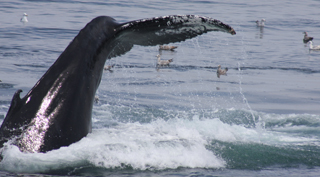
Kick Feeding
May 8th was a perfect day for whale watching with bright skies and calm seas. Towards the beginning of the trip we observed a minke whale, the second smallest baleen whale in the world. Minke’s are currently not considered to be endangered and consequently are the most heavily hunted whales in the world; they are also relatively fecund as it is thought that adult females can give birth every year. Shortly after leaving our minke whale we came across two pods of Atlantic white-sided dolphins that were milling around, close to humpback whales. One of the humpbacks that we observed became curious of our boat and spy-hoped! Spy hopping allows whales to see objects around them more clearly by getting their eyes above sea level. Sometimes spy-hopping humpbacks are referred to as pickles because of the bumps (tubercles which are hair follicles) on the top of the whale’s head. Towards the end of our trip we found Reflection who was engaging in various feeding behaviors, such as kick-feeding and bubble clouds. Humpbacks have very elaborate feeding strategies. We also saw Walrus and various juvenile whales.
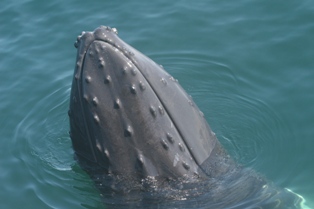
Spy-Hopping
Despite unfavorable weather on May 9th, we had unbelievable humpback sightings in Cape Cod Bay. Three different humpbacks became curious of our vessel. As our boat remained in neutral, the whales swam under and around us, allowing everyone to get a sense for the size and shape of the animals. We could clearly see that humpbacks like other baleen whales have two blowholes on the top of the head, as well as tubercles or hair follicles, barnacles and ventral pleats. The Captain could actually see the whales travel 30 feet directly under our boat with his sonar, soon to pop up on either side of our boat. Some passengers were so close they got covered in whale breath!
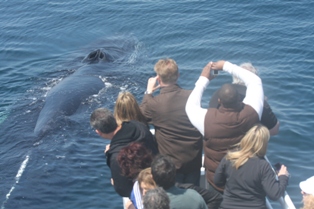
Curious Humpback
With bright, clear skies and moderate seas we traveled out of Cape Cod Bay to Race Point on May 10th to observe various humpback whale behaviors. We had one juvenile humpback that put on quite the show, with breaching and flipper slapping! Although it is currently unclear why humpbacks exude such active behaviors, it has been demonstrated that breaching often increases in frequency when the winds are strong—such as they were today! After leaving our active humpback we found three other whales that were traveling near the surface. These whales appeared to be traveling linearly which means that they were on a set path, surfacing several times in an almost straight line. When whales are seen traveling randomly, surfacing in different locations with no clear path, it is thought that they are searching for food.
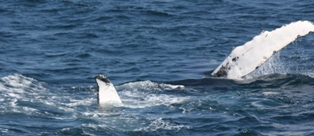
Flipper Slapping
On May 11th we traveled out of Cape Cod Bay to the Coastguard Station on the backside of Cape Cod and saw a myriad of humpback whales, many of which were engaging in elaborate feeding behaviors. 6 of our humpbacks were kick feeding and surface lunging, while 4 others were making bubble clouds after their kick feeds. Although many humpbacks share similar feeding behaviors, individuals differ in their feeding styles. Some whales will do small chin-breaches before a kick feed, others will surface on their side after bubble clouds and some will snake across the surface to expel the salt water inside their mouths. While on the feeding grounds, humpbacks will eat approximately 1 ton of sand lance per day to replenish their depleted blubber reserves. Cetaceans rely on their blubber for insulation, buoyancy and energy. Blubber is a dynamic tissue, changing over time and consequently can demonstrate the nutritional state and life history stage of individuals. Healthy whales will often have a thick blubber layer, while those in poor health often have a thin blubber layer. Among the 10 feeding humpbacks were Rapier, Glo and Midnight.
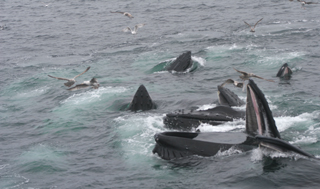
Open Mouth Feeding





